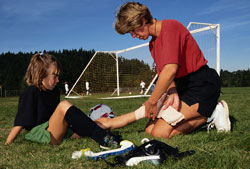
Common injury
- The ankle is the most common injury in many sports, accounting for 15.3% of all injuries in high school sports, with ankle sprains accounting for 88.9% of the total. (1)
- At the high school level, boys' and girls' basketball, and girls' gymnastics have the highest rate of ankle sprains. (1)
- Girls are significantly more likely to sustain ankle sprains than boys in soccer, softball, and track and field. (1)
- In soccer, the risk of injury during match play is 4 to 6 times greater than during training. (2)
At the time of injury
If a child injures an ankle during practice or competition:
- He or she should stop playing immediately. Have her sit down in the middle of the field or the court if she has to.
- Once off the field or court, examine the ankle closely. If it looks different from the child's other ankle, of if the child hears crunching noises when she tries to move it, the ankle might be broken, which requires immediate medical attention and a trip to the hospital emergency room for an examination and x-rays (A list of emergency phone numbers should be kept in the first-aid kit.
- If the child experiences any severe pain, he might have a second — or third-degree sprain, with a partially or completely torn ligament. These injuries need to be treated by a doctor. Because most sprains can wait to be treated your child's primary care physician, her office can give you advice over the phone, if necessary, on how to help your child over night until he can be seen during the doctor's regular office hours.
- Stay calm and calm the injured player. Keep others away from her as much as possible.
Return to sports
It is important in all but mild cases for a medical doctor to evaluate the injury and establish a treatment and rehabilitation plan.
You and your child should treat any ankle sprain, but especially the first one, seriously. An athlete who fails to allow an ankle sprain to properly heal is at risk for developing chronic ankle instability. Indeed, once an ankle sprain occurs, up to 80% will suffer recurrent sprains, and up to 72% develop recurrent symptoms or chronic instability. (2) Basketball players are 5 times more likely to injure an ankle after a prior ankle injury, with a recurrence rate of 73%. Recurrence most strongly correlates with a premature return to play and a prior ankle injury.
Sports medicine experts, like Dr. Lyle J. Micheli of Children's Hospital Boston, recommend that the rehabilitation process be supervised by a qualified physical therapist, and that a child not be allowed to return to sports until:
- Full range of pain-free motion in the ankle is regained
- He can run and walk without limping
- He has more than 90 percent strength in the injured ankle compared to the uninjured ankle (athletes with deficits in strength and flexibility are more prone to leg injuries; those with muscle strength imbalance are at increased risk of ankle injuries)[Note: the NATA's 2013 position statement on the treatment of ankle injuries (3) says the injured limb should measure at least 80% of the uninjured limb]; and
- He can reach maximum speed while running and changing direction (ankle injury often impairs agility in comparison to uninjured ankles).
- Dorsiflexion Lunge Test to test range of motion
- Star Excursion Balance Test to test balance and proprioception
- Agility T-Test to test agility, which is often impaired in ankle injuries; and
- Sargent/Vertical Jump Test to evaluate strength.
When your child is ready to return to sports:
- Make sure he does some running and skill drills on his own to make sure the ankle is okay; going into a game "cold turkey" is a good way for your child to re-injure the ankle;
- Have an athletic trainer tape up the previously injured ankle;
- If no athletic trainer is available, have him wrap the ankle himself or wear a removable brace, such as an Aircast. In fact, some experts, like Dr. Micheli, believe that modern braces are more convenient and effective than traditional taping. (Note: taping and fancy bracing do no more to prevent ankle injuries than properly fitted shoes.)
- If pain or swelling returns, have your child stop playing, tell the coach, and contact your child's doctor to arrange for a re-evaluation.
- Remember that taping or braces should be used along with, not instead of, rehabilitation.
Finally, your child needs to demonstrate psychological readiness to return to play. (2) This is because athletes who demonstrate apprehension, fear, or anxiety are at a much greater risk of reinjury, and their athletic performance is also likely to suffer.
1. Swenson D, Collins C, Fields S, Comstock R. Epidemiology of US High School Sports-Related Ligamentous Ankle Injuries, 2005/06-2010-11. Clin J Sport Med 2013;23(3):190-196
2. Clanton TO, Matheny LM, Jarvis HC, Jeronimus AB. Return to Play in Athletes Following Ankle Injuries. Sports Health: A Mulidisplinary Approach 2012;20(10). DOI 10.1177/1941738112463347 (published on line October 11, 2012 ahead of print)(accessed October 12, 2012).
3. Kaminski TW, Hertel J, Amendola N, Docherty CL, Dolan MG, Hopkins TJ, Nussbaum E, Poppy W, Richie D. National Athletic Trainers' Association Position Statement: Conservative Management and Prevention of Ankle Sprains in Athletes. J Athl Tr 2013;48(4):528-545.
Updated March 29, 2015








